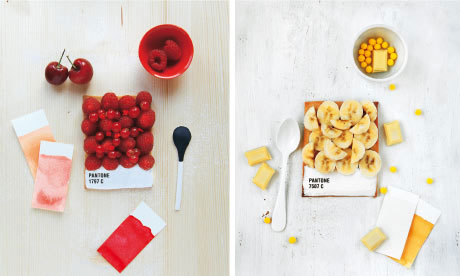
A few years ago, I wrote a cookery book called Cherry Cake And Ginger Beer that was inspired by the delicious food and treats enjoyed by the characters in children's classics. There were recipes for Mary Poppins' Raspberry Jam Cakes, Swallows and Amazons' Seed Cake, and Anne of Green Gables' Layer Cake. The idea emerged on a family holiday during a conversation with my then nine-year-old daughter, who at that point was engrossed in a marathon reading of Enid Blyton's Five Find-Outer series, which contains multiple references to macaroons and fry-ups. As I was also something of a greedy reader when young, together we decided to ransack the library to create a collection of recipes that could be made with and by children who wondered how the foodstuffs that are so avidly consumed on the page actually taste off the page.
As it now turns out, the book was an early example of a new phenomenon that sees adventurous cooks finding inspiration everywhere but in a recipe book. Today, there is a flourishing movement of food from art and food as art, with young food writers and stylists mining painting, design, literature, poetry and even Pantone charts for ideas, and using them to create strikingly original dishes and recipes.
Megan Fizell, an Australian based in Sydney, is an art historian who began her Feasting On Art blog in 2009 as a way of combining her interests in food and art. The results are rarely a direct recreation of the image, but more image-inspired. So Cézanne's Still Life With A Plate Of Cherries (1885-87) is the jumping-off point for a rich and fruity cherry and nectarine clafoutis, while a glorious vase of red poppies painted by Van Gogh is the basis for lemon and poppyseed bread.
The blog is richly creative and educational, with each post providing a very palatable side dish of art history. It's also refreshingly down to earth, as Fizell tells of the challenges, difficulties and mess. Unlike more professionally produced shoots and articles, there is no pretence of perfection.
While her savoury dishes are historically accurate and authentic, many will be wowed by the sweet things she creates, the fabulous geometric Mondrian pound cake, colourful, circular Hirst cineole cupcakes, and Warhol-esque tomato soup cake. A chicken is a chicken, but sponge, icing, chocolate and food colouring are the kitchen creator's media, just as clay, stone and paint are for the sculptor or painter. In fact, there is little in the artist's studio that cannot be substituted in the kitchen.
Take colour charts, for example. Emilie Griottes was inspired by the Pantone colour chart to create a range of Pantone tartes. Griottes is a French food stylist and, although she gives recipes, the tarts are really for looking at admiringly, wonderingly, while you ask yourself why you never thought a banana, marshmallow or apricot was an example of a Pantone reference rather than simply a food. Hers is a playful approach, the grown-up version of the food art created spontaneously by children who arrange alphabet spaghetti into words and draw faces with ketchup.
Equally creative, but more low-key and with a plain, contemporary, fashionably stark aesthetic is the series of Fictitious Dishes, by Dinah Fried, an American graphic designer and photographer who takes famous literary meals and turns them into artfully arranged pictures on her website. So Oliver Twist's bowl of gruel is suitably meagre and miserable, while the famous chapter on chowder in Moby Dick is distilled into a thick, pale, appetising clam chowder (for another take on this, as well as Jane Eyre cardamom seed buns and Toni Morrison tribute beloved blackberry tart, check out Cara Nicoletti's yummy-books.com).
Fried's photographs are shot from above, so that they look like paintings, with the food arrangement becoming a modern-day still life. Since there is no text to explain anything, the images have the reverse effect of sending you back to the classics to read and digest the food sections on the page. There are just five dishes in the series so far, but Fried is asking for suggestions, so perhaps we can look forward to her interpretation of Miss Havisham's wedding feast or the wonderful descriptions of food in Sylvia Plath's The Bell Jar or George Orwell's Down And Out In Paris And London.
Fried's approach is to stay close to the inspiration but to give it a cool, modern twist, whereas Eat This Poem, a blog written by young American poet, Nicole Gulotta, has a more reverent tone. It offers up recipes inspired by the spirit and mood of her chosen poems, mostly by contemporary US poets but with a few by writers such as Elizabeth Bishop and William Carlos Williams. Gulotta's dishes and writing are more tangential and esoteric. She is at her best, and the connections most interesting, when she is inspired by a poem that contains a direct reference to a foodstuff, such as when she selects Pablo Neruda's Ode To An Onion to create a rich and comforting onion galette with blue cheese and honey.
It's vibrant, energetic and very modish, but this style of arty food also raises the question of "gastro porn". Some certainly give out a look-but-don't-eat message, but the most successful combine fun and inventiveness to produce something you know will taste great and – you hope – be eaten with relish.
Taking art and literature as inspiration means no rules, and the freedom to express your culinary creativity as you please, according to your vision and the contents of your cupboards. It's a far cry from the hand-holding of our usual kitchen guides. If you don't know what to make tonight, start by putting away those recipe books.
• Jane Brocket's new book, Vintage Cakes, is published by Jacqui Small in September at £25. To pre-order a copy for £20, including free UK mainland p&p, go to guardian.co.uk/bookshop, or call 0330 333 6846.

